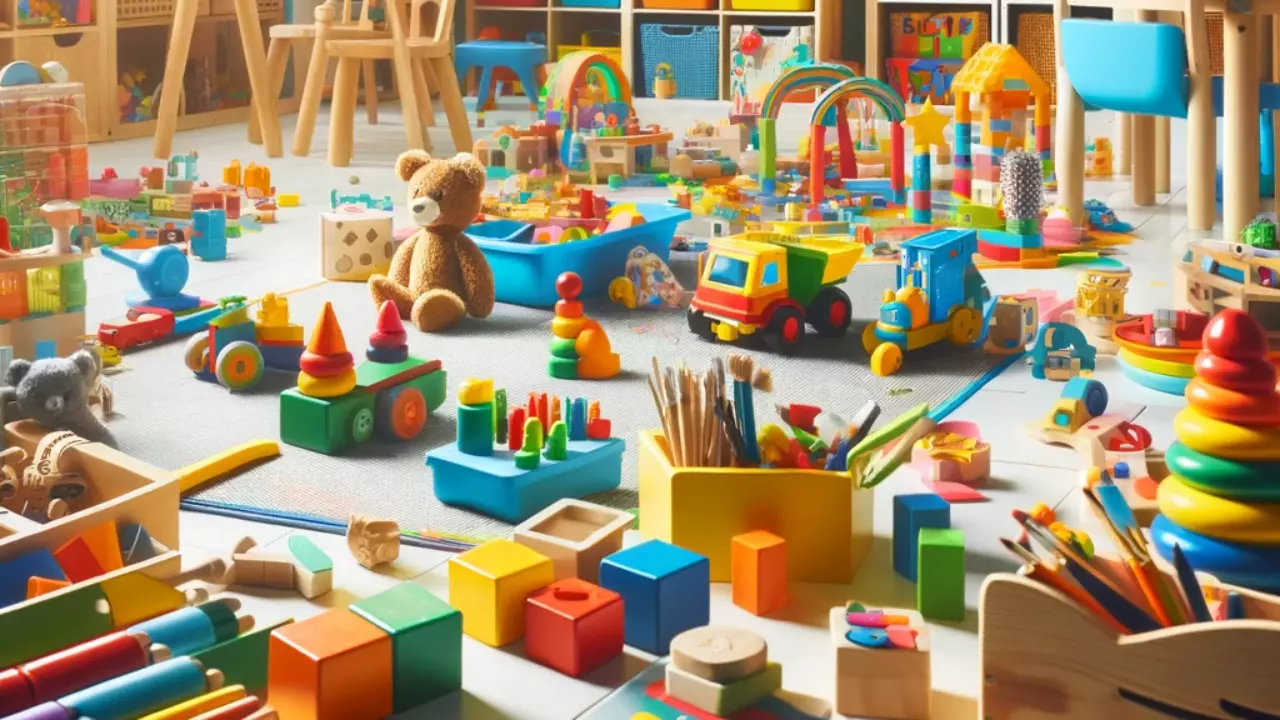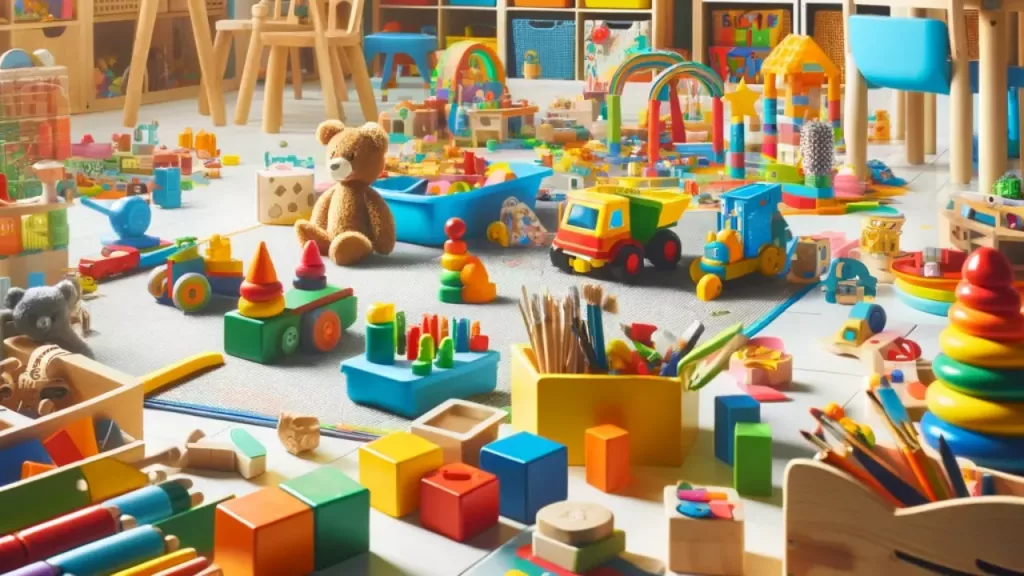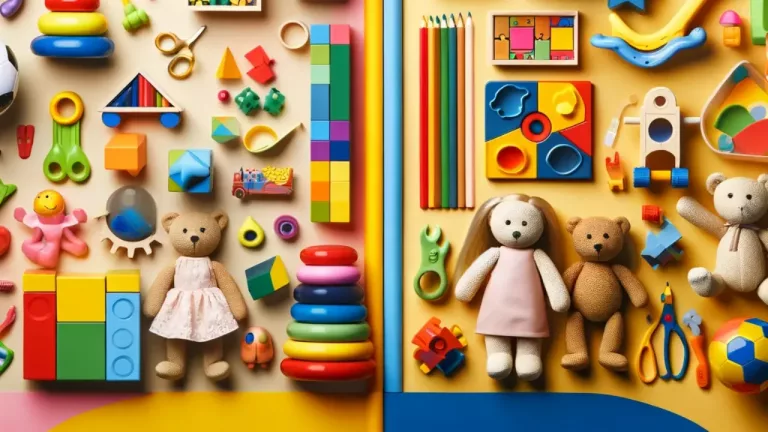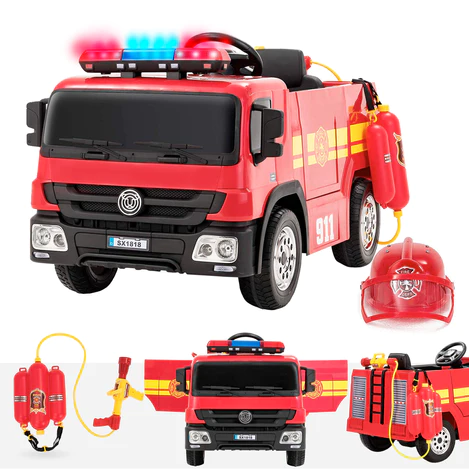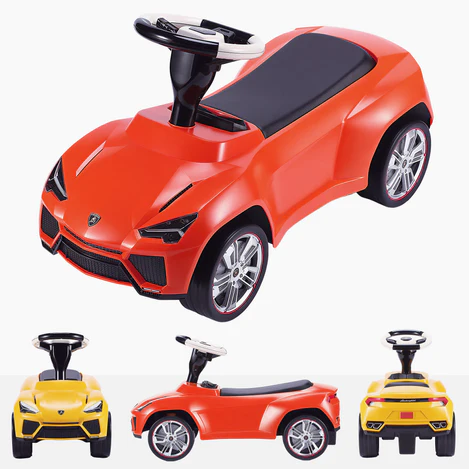In the world of parenting and education, selecting the right toys for our children can often feel like navigating through a maze.
With the overwhelming variety of toys available, how do we choose the ones that will enrich our children’s playtime and aid their development?
This guide focuses on open-ended toys – a category of playthings that are instrumental in fostering creativity, imagination, and cognitive skills in young minds.
Here, we’ll delve into the essence of open-ended toys, their benefits, and how to choose the best ones for your child.
Table of Contents
ToggleUnderstanding Open-Ended Toys
Open-ended toys are like blank canvases for a child’s imagination. Unlike traditional toys with a predetermined purpose, these toys invite children to create their own stories and ways to play.
This section will explore the vital role these toys play in nurturing a child’s creativity and problem-solving abilities.
Check out our guide to the latest in UK toy trends and industry statistics, showcasing the popularity of eco-friendly and educational toys and the growing preference for online purchases.
An informative piece for parents, educators, and anyone interested in the current state of the toy market.
Why Open-Ended Toys Matter
The significance of open-ended toys in child development cannot be overstated.
These toys encourage children to think independently, make choices, and express their ideas creatively.
Let’s delve deeper into why these toys are essential for your child’s growth.
Benefits of Open-Ended Toys for Child Development
Cognitive, Emotional, and Social Growth
Open-ended toys are not just playthings; they’re tools for holistic development.
From boosting cognitive abilities to enhancing emotional intelligence and social skills, these toys have a profound impact on a child’s overall growth.
Discover how they contribute to different aspects of development.
Independence and Creative Thinking
Through play, children learn to make decisions, solve problems, and think creatively.
Open-ended toys provide the perfect platform for this kind of learning, helping children develop independence and innovative thinking skills.
Identifying High-Quality Open-Ended Toys
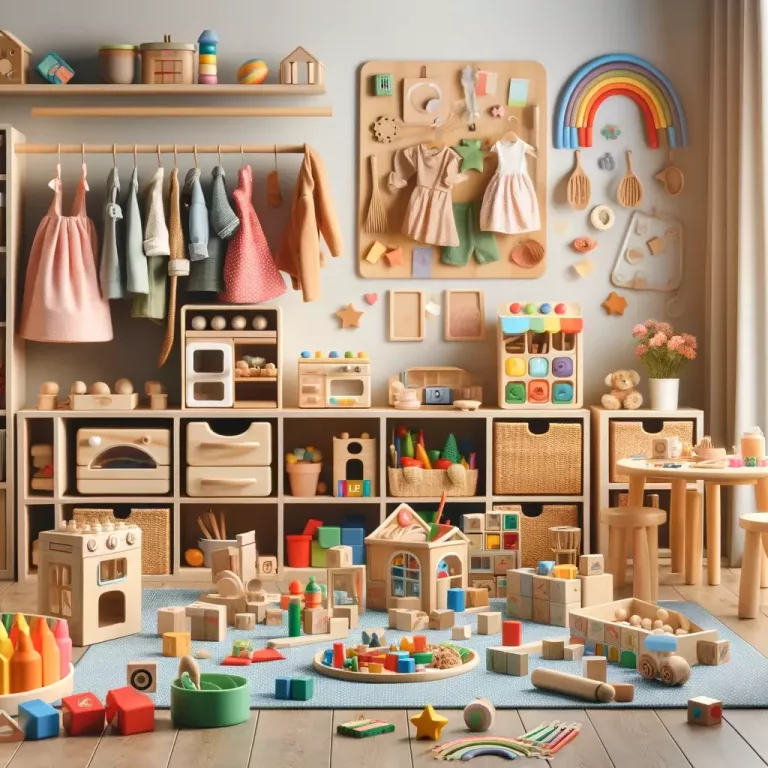
Characteristics of Ideal Toys
What makes an open-ended toy stand out?
Here, we’ll discuss the essential features of high-quality open-ended toys, including their versatility, safety, and age-appropriate design.
Simplicity and Age-Appropriate Design
Learn how the simplicity of a toy can enhance a child’s play experience and why it’s crucial to choose toys that are suitable for your child’s age and developmental stage.
Comprehensive Guide to Selecting the Right Open-Ended Toys
Age-Specific Recommendations
When selecting open-ended toys, it’s crucial to consider the age and developmental stage of your young child.
For toddlers (1-3 years), sensory playthings like textured blocks or simple games are perfect.
Preschoolers (3-5 years) will enjoy more complex creative toys, such as arts and crafts materials, which encourage imaginative play.
For children aged 5-8 years, look for toys that challenge their cognitive skills, like intricate Lego play sets or science kits.
Aligning with Interests and Safety Assessment
Select toys that resonate with your child’s interests to keep them engaged and entertained.
If your little one is fascinated by the natural world, animal figurines can inspire hours of imaginative play.
Always prioritise safety by choosing non-toxic, durable toys, especially for youngsters.
Avoid toys with small parts for younger children and always adhere to safety standards and certifications.
Educational Value vs. Fun
Balancing educational value with fun is essential when choosing children’s toys.
Magnetic tiles, for instance, can teach geometric concepts while providing a fun and creative play experience.
Art supplies, another great choice, not only bolster creativity but also improve fine motor skills, offering both amusement and learning.
Diversity, Inclusivity, and Sustainability
Choose playthings that reflect our diverse society.
Dolls representing different cultures promote inclusivity and broaden children’s understanding of the world.
Sustainability is vital; opt for toys made from renewable resources, echoing the importance of environmental care to your child.
This not only protects the environment but also teaches children the importance of sustainability.
Budgeting for Value and Interactive Play
When budgeting for children’s toys, consider long-term value. Durable, high-quality toys might cost more initially but are more cost-effective over time.
Toys that encourage interactive play, like board games, not only enhance social skills but also provide countless recreational activities for the whole family.
Additionally, choose toys that encourage interactive play, like board games or construction sets, which can help develop social skills and cooperation.
Evaluating the Longevity and Adaptability of Toys
When selecting open-ended toys, it’s important to consider their longevity and adaptability.
Look for toys that can evolve with your child’s growing abilities and interests.
For instance, simple blocks can be used for basic stacking in younger children and evolve into complex structures as they grow.
This not only ensures the toy remains engaging over the years but also offers better value for money.
Popular Open-Ended Toy Examples
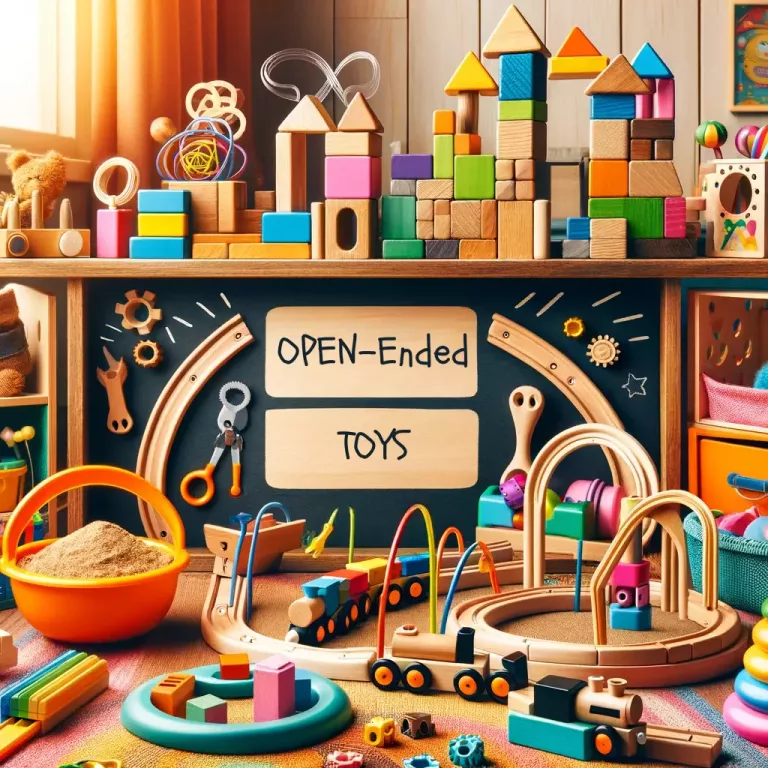
Toys That Grow with Your Child
Consider toys like building blocks and play silks that adapt to your child’s changing interests.
These toys can be simple enough for a preschooler yet intriguing enough for an older child, demonstrating their flexible and adaptable nature.
They are perfect for imaginative play sessions, whether during fun time or as part of structured recreational activities.
Related: Open-Ended vs. Closed-Ended: Understanding the Play Value of Different Toys
Facilitating Creative Play with Open-Ended Toys
Strategies for Parents
Learn how you, as a parent, can encourage your child to use open-ended toys creatively, fostering their imagination and independence in play.
Guiding Play without Imposing Rules
Discover the art of guiding your child’s playtime without strict rules, allowing their creativity and problem-solving skills to flourish.
Providing Space and Freedom for Play
Creating a dedicated space or area in your home where your child can engage with their toys is crucial.
This play space doesn’t need to be large; a small, well-organised room or corner can suffice.
Ensure this space is safe and inviting, where your youngsters can dive into their make-believe worlds without restrictions.
Integrating Open-Ended Toys into Daily Routines
Incorporating open-ended toys into your child’s daily routine can be seamless and highly beneficial.
Encourage your child to play with these toys during different times of the day – perhaps building blocks in the morning, imaginative role-play after lunch, and creative art in the evening.
This integration helps establish a routine that fosters continuous learning and creativity, making play an integral part of their daily life.
Balancing Open-Ended and Structured Play
While open-ended play is crucial for fostering creativity and independence, structured play also has its place in a child’s development. It’s important to strike a balance between the two.
Structured play, such as puzzle-solving or following game rules, develops different skills like following instructions and problem-solving within constraints.
Balancing both types of play ensures a well-rounded developmental experience for your child.
Understanding the Role of Technology in Open-Ended Play
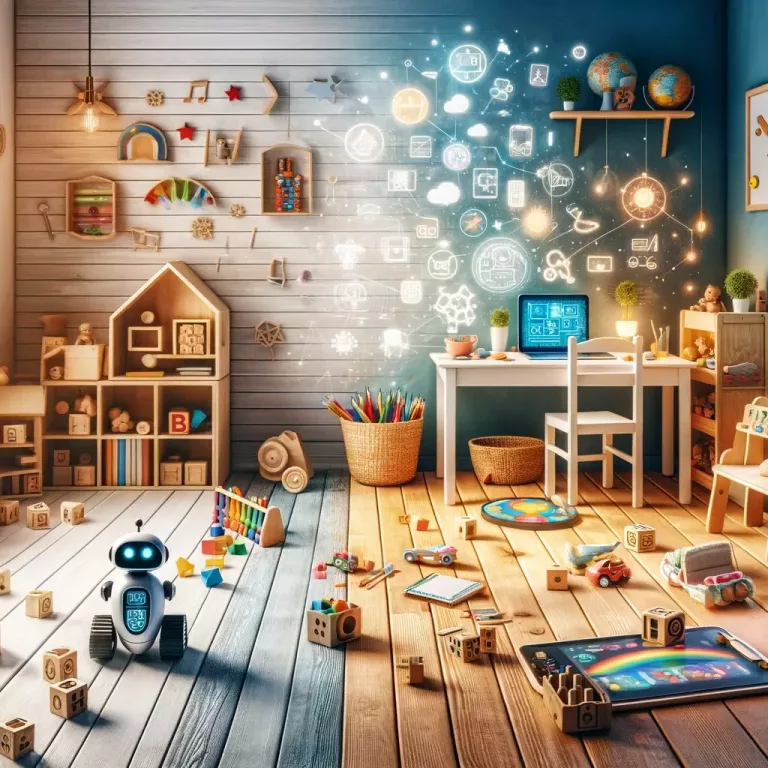
Today, it’s important to find a balance between screen-based games and physical toys.
While apps and online games can offer a form of creative play, they should complement, not replace, the tactile experience provided by physical toys.
Encourage playtime that creatively blends both, ensuring a healthy mix of activities and recreational pastimes.
For instance, a construction game app can be a great tool for planning a real-world building project with blocks.
It’s all about finding the right balance and ensuring technology enhances rather than detracts from the open-ended play experience.
The Role of Parents and Caregivers in Open-Ended Play
Guiding Young Minds in Play
Parents, caregivers, moms, dads, guardians, and family members play a pivotal role in facilitating open-ended play. Your involvement can turn simple playtime into an extraordinary opportunity for learning and growth.
Encourage your kids to explore different ways to use their toys, turning every plaything into a versatile and multi-purpose tool for imagination.
Conclusion
Choosing the right open-ended toys for your child is an investment in their future.
By focusing on toys that encourage creativity, problem-solving, and independent thinking, you’re setting the stage for a well-rounded development.
Remember, the best toy for your child is one that matches their developmental stage, ignites their imagination, and brings joy to their playtime.
So, take these guidelines with you on your next toy hunt and watch your child’s world expand with endless possibilities of play and learning.
FAQs About Choosing the Best Open-Ended Toys for Kids
Open-ended toys differ from traditional toys in their ability to foster creativity and imagination. Traditional toys often have a specific purpose or way to play, like puzzle pieces that only fit in one way. In contrast, open-ended toys, such as blocks or art supplies, can be used in numerous ways, encouraging children to create their own games and stories. This flexibility helps in developing critical thinking and problem-solving skills.
A toy is considered open-ended if it can be used in various ways and doesn’t lead to a single outcome. Check if the toy allows for multiple methods of play and if it can be integrated into different scenarios your child invents. For example, a simple set of wooden blocks can be a castle, a spaceship, or a landscape, depending on the child’s imagination.
Balancing time between open-ended toys and structured educational activities is key to a well-rounded development. Open-ended toys offer creative freedom and foster imagination, while structured activities provide specific learning outcomes and teach discipline. Aim to create a schedule that alternates between free play with open-ended toys and structured learning times, such as reading, puzzles, or educational games. This balance ensures that your child develops creativity alongside specific skills and knowledge.
For toddlers, sensory toys like sand and water tables, large building blocks, and simple art supplies like large crayons and paper are excellent. These toys help toddlers explore textures, shapes, and colours. Look for toys that are safe for their age, free of small parts, and encourage exploration and sensory play.
